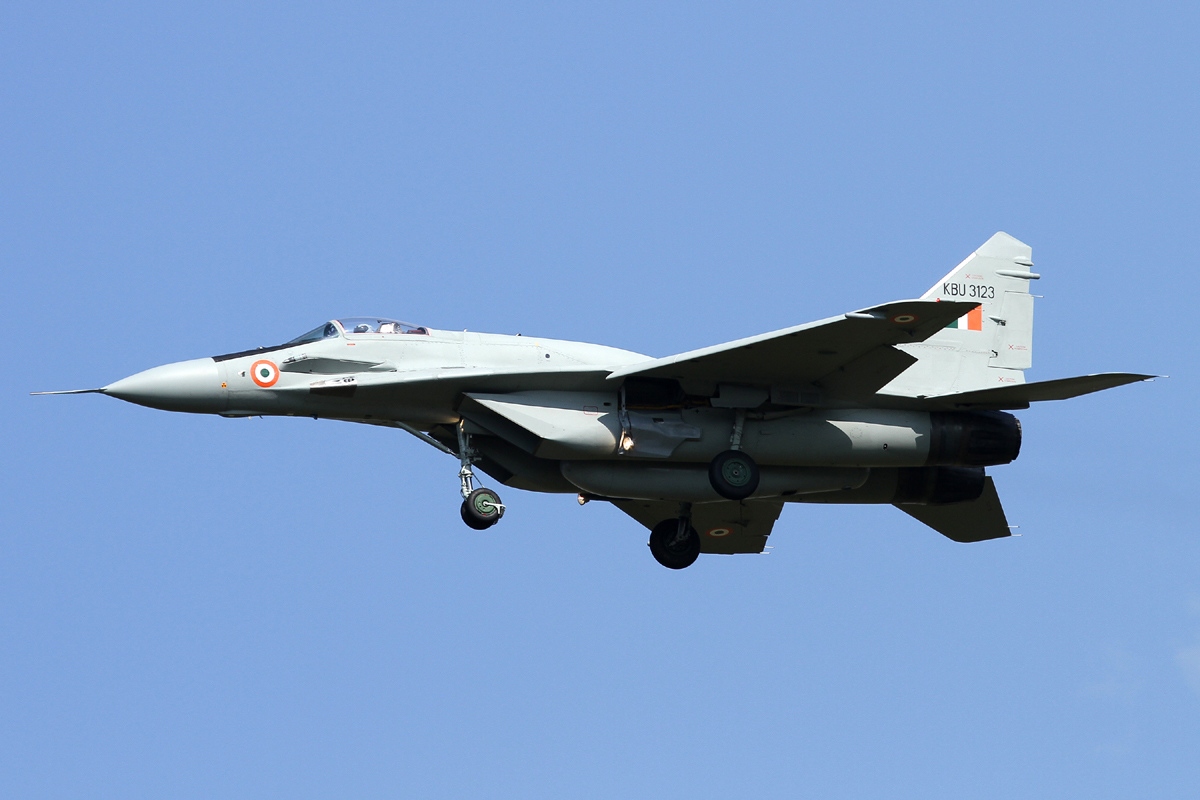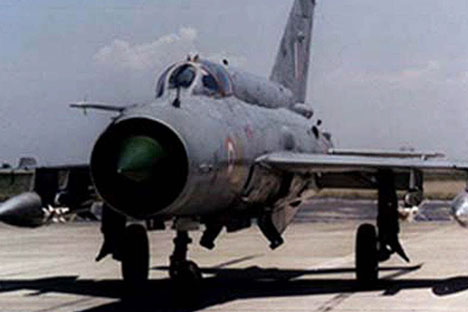How the IAF dominated the skies during Kargil War

IAF MiG-29.
Aktug Ates/wikipedia.orgIndia was minutes away from bombing Pakistan on June 13, 1999 during the Kargil War. The Indian Air Force had deployed 16 jet fighters, mostly MiGs, for carrying out attacks deep into enemy territory. Although the final clearance to cross the Line of Control (LoC) in Kashmir was never given by the political leadership, the IAF was able to inflict considerable damage on Pakistani forces while operating within the confines of its own airspace.
The IAF’s employment of airpower against Pakistan Army positions at Himalayan heights of 18,000 ft – unprecedented in the history of aerial warfare – achieved three key objectives: it ensured an early Indian victory, demoralised the Pakistani military and showed the limitations of nuclear deterrence.
Because of the aerial superiority achieved by the IAF in the war – and later during the 2002 border standoff – the Pakistan Air Force’s “psyche took a big beating”, says a Strategy Page report.
While a number of IAF aircraft took part in the Kargil campaign, it was the cover provided by the MiG-29 Fulcrum armed with beyond visual range (BVR) missiles that exposed the PAF’s plight. “Analyses by Pakistani experts revealed that when the rubber met the road, PAF simply refused to play any part in support of the Pakistan Army, angering the latter,” says the report.
“While PAF fighters did fly Combat Air Patrols (CAP) during the conflict, they stayed well within Pakistani air space. On occasions, IAF MiG-29s armed with the deadly R-77 BVR air-to-air missiles were able to lock on to PAF F-16s, forcing the latter to disengage. In the absence of a PAF threat, the IAF was able to deliver numerous devastating strikes on intruder positions and supply dumps.”
The situation changed little during the 2002 border crisis between India and Pakistan. Strategy Page adds: “One Pakistani military expert observed that the PAF’s perceived inability to defend Pakistan’s airspace and even put up a token fight against the IAF was the biggest driver for Pakistani leaders’ warnings that any Indian attack would lead to an immediate nuclear strike by Pakistan. It would be no exaggeration to say that after the Kargil and 2002 experiences, PAF’s psyche took a big beating.”
In the report “Airpower at 18,000 feet: IAF in the Kargil War” published by the Carnegie Endowment for International Peace in 2012, Benjamin Lambeth explains in detail how the IAF ground down both the Pakistan Army and the PAF: “Throughout the campaign, whenever IAF reconnaissance or ground attack operations were under way in the immediate combat zone, Western Air Command ensured that MiG-29s or other air-to-air fighters were also airborne on combat air patrol stations over the ground fighting on India’s side of the LoC to provide top cover against any attempt by the PAF to enter the fray in a ground attack role. PAF F-16s to the west typically maintained a safe distance of 10 to 20 miles on the Pakistani side of the LoC, although they occasionally approached as close as 8 miles away from the ongoing ground engagements.”
Lambeth quotes Air Marshal (retired) Vinod Patney, the then head of Western Air Command: “I think my insistence to mount CAPs across the (command’s entire area of responsibility) at different heights and times to give the message that I was ready and angling for an enlarged conflict helped. It was akin to throwing a glove, but it was not picked up.”
Although IAF fighters never joined in aerial combat with the PAF F-16s due to the Atal Bihari Vajpayee government’s strict injunction that Indian forces not cross the LoC, years later IAF chief Anil Tipnis recalled he had “personally authorised his escorting fighter pilots to chase any Pakistani aircraft back across the LoC in hot pursuit were those pilots to be engaged by enemy fighters in aerial combat”.
Operation Vijay
It was when an IAF reconnaissance aircraft sustained a direct hit from a Chinese made Anza shoulder-fired surface to air missile launched by Pakistani intruder, that the IAF launched Operation Vijay to clear the Himalayan peaks. In the early hours of May 26, 1999 six attacks in succession by MiG-21, MiG-23 and MiG-27 fighters were launched against intruder camps, materiel dumps, and supply routes in the areas overlooking Dras, Kargil and Batalik.
The MiG-21bis squadron at Srinagar was joined by additional MiG-21M, MiG-23BN and MiG-27ML squadrons, while additional squadrons of MiG-21Ms and MiG-29s deployed northward to Avantipur.
While the MiG-29s kept the F-16s bay, the other IAF aircraft carried out ground sorties.
An example of Indian jugaad – or improvisation – was the use of stopwatches and handheld GPS receivers in their cockpits by MiG-21 pilots lacking sophisticated onboard navigation suites. According to Prasun K. Sengupta in “Mountain Warfare and Tri-Service Operations”, another novel technique developed by the IAF for use in the campaign entailed selecting weapon impact points so as to create landslides and avalanches that covered intruder supply lines.
Air Marshal Patney said one of his younger pilots decided to carry a small video camera with him in a fighter and to film the area of interest so that an immediate reconnaissance report was available and at an expanded scale. On another instance, the IAF used the MiG-25R – which normally flies at 80,000 ft – in a medium altitude role to improve the resolution of its pictures, something that the aircraft’s Russian designers may not have thought possible.
Laser strikes
However, the MiG-21s, MiG-23s and MiG-27s – lacking modern weapons – were not making a significant impact on hard to locate enemy positions. MiG-23 and MiG-27 pilots were used to manual dive bombing runs, and this tactic wasn’t suited in the rarefied atmosphere of the Himalayas. At this point, the IAF introduced the Mirage 2000H equipped with day and night laser-guided bomb delivery pods.
On June 24, two Mirage 2000Hs, in the first-ever combat use of laser-guided bombs by the IAF, struck and destroyed the Northern Light Infantry’s command and control bunkers. According to Lambeth, “For this pivotal attack, the IAF waited until the encampment had grown to a size that rendered it strategically ripe for such targeting.”
The IAF reported at the end of 1999 that it resulted in as many as 300 enemy casualties within just minutes. Radio intercepts by Indian intelligence revealed severe shortages of rations, water, medical supplies and ammunition, as well as an inability of the occupying enemy units to evacuate their wounded, writes D.N. Ganesh in “Indian Air Force in Action”.
As stated in US air manuals, “Air power produces physical and psychological shock by dominating the fourth dimension of time. Shock results in confusion and disorientation.” At the same time, the Indian Army was pounding away at the Pakistani positions with its heavy artillery. The continuous barrage of bombs exploding around them day and night had a devastating effect on the Pakistani intruders.
The effectiveness of the IAF’s operations can be measured by the fact that Pakistan’s Foreign Minister Sartaj Aziz, rushed to New Delhi on June 12, and implored India to “stop its air strikes”. You don’t get more desperate than that.
Endgame
However, the most telling statement on the war was made by India’s then defence minister George Fernandes. In January 2000 he observed that in precipitating the Kargil War, Pakistan “had not absorbed the real meaning of nuclearisation – that it can deter only the use of nuclear weapons, but not all and any war”.
(This is an updated version of Rakesh Krishnan Simha’s article published in January 2013.)
All rights reserved by Rossiyskaya Gazeta.
Subscribe
to our newsletter!
Get the week's best stories straight to your inbox


